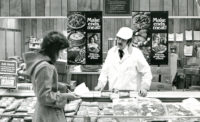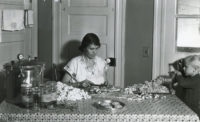Editor’s Note: Following is the first of six reports (appearing in 25-year increments plus one present/future report) covering magazine highlights and major industry events during The National Provisioner’s 125 years in publishing.

Two months after the Dalton Gang’s first train-robbery attempt of Southern Pacific No. 17 near Alila, Calif., the premiere issue of The National Provisioner (NP) was published April 11, 1891, by Ganz & Marx in New York.
Published weekly each Saturday as a “journal of record and information in the interest of packers, provision leaders, butchers, meat dealers, livestock dealers, poultry dealers and auxiliary industries,” early issues of the publication little resemble NP today.
Front and back covers were heavier stock, sienna-colored paper containing various sized advertisements primarily touting pioneering ice-making/refrigeration machines and meat production equipment. Cover and inside graphics were few, limited to sketches of equipment and eventually some head shots of industry leaders. But its content always was and remains extraordinary to see and read.
NP founders Robert Ganz and Sidney J. Marx believed trade journals should strive to be something more than mere records of trade news. Early issues featured hard-hitting editorials, informative features, plus fact-filled news articles covering legislation, government investigations of industry practices, market and export updates, animal and disease research, new plant construction, industry litigation and more.
Additional Content:
Meat Industry Timeline - View Now
Guest column by Rosemary Mucklow - Read Now
The first 25 years
“From 1891-1916, industry experienced expansion and corporate consolidation of large-scale, factory-like hog and cattle slaughter — which was still quite new in 1891,” says Maureen Ogle, Ames, Iowa-based historian and author of In Meat We Trust among other works.
In 1891, only several packer specialists handled meat canning. Libby, McNeill & Libby; Fairbank Canning Co. (a Morris property); Wilson Packing Co.; St. Louis Beef Canning Co.; and Armour & Co. were the most prominent canners from 1880 to 1900. More-progressive meat plants in the U.S. began employing power-operated machines, including hoists, dehairers, presses, silent cutters, dryers, refrigeration compressors and grinders. Chains were limited — conveyor tables didn’t exist yet.
Pork packers evolved into meatpackers that slaughtered, processed and distributed a variety of fresh and cured meats year-round for domestic and international markets. Packers were primarily bulk operators, excluding several canned meat and sausage businesses. But in 1891, the new Imperial (later Beech-Nut) Packing Co. began packing sliced bacon into one-pound boxes — an industry first.
During NP’s first 25 years, new, unique slaughter and production plants were increasingly built throughout the country, and the magazine increased coverage of new plants that were built domestically and abroad. For example, a new Morrell Meat Packing Co. plant complex being built in Sioux Falls, S.D., for approximately $750,000 was featured in NP’s May 6, 1911, issue. It consisted of 10 buildings, some six and seven stories tall — as opposed to the largely single-story plants of today.
NP urged readers to use new and evolving artificial refrigeration/ice production systems and equipment rather than less-sanitary natural ice; and to adopt/expand electricity use in slaughter/packing plants. Further, NP updated readers on the expanding railway and shipping transportation of live cattle and refrigerated meat products to domestic and foreign markets. Each of these advancements was transforming industry in major ways.
NP was proactive on several issues right from the start. During its first 25 years, it urged industry to treat food animals humanely, discouraged horse meat processing and urged industry to stay ahead of foreign meat competitors, such as Argentina and Australia, among other things.
1906: A pivotal year
Published on Feb. 26, 1906, Upton Sinclair’s “The Jungle” horrified many citizens with its graphic, unflattering description of poor working conditions in U.S. meatpacking plants. Public outcries combined with sensationalized general press attacks against industry were cited for helping to usher in the passage of The Meat Inspection Act of 1906, signed on June 30 by President Theodore Roosevelt. This act defines adulteration, provides for federal inspection of meat products, outlaws interstate transportation of adulterated foods and prohibits misbranding of food and drugs, and NP supported this move.
On Oct. 6, 1906, the American Meat Packers Association (AMPA) was formed at a meeting, called for by NP, by more than 100 meat companies in Chicago. AMPA, the first national trade association created to deal with problems confronting the U.S. meat industry, exists today as the North American Meat Institute.
As NP’s first 25 years drew to a close in 1916, industry unknowingly was about to be drawn into World War I the following calendar year, and canned meats would once again serve as vital precious battle rations for U.S. and allied troops. NP







